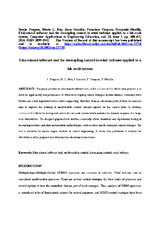Mostrar el registro sencillo del ítem
Educational software tool for decoupling control in wind turbines applied to a lab‐scale system
| dc.contributor.author | Fragoso, Sergio | |
| dc.contributor.author | Ruz Ruiz, Mario L. | |
| dc.contributor.author | Garrido, J. | |
| dc.contributor.author | Vázquez Serrano, Francisco J. | |
| dc.contributor.author | Morilla, Fernando | |
| dc.date.accessioned | 2018-10-30T13:16:27Z | |
| dc.date.available | 2018-10-30T13:16:27Z | |
| dc.date.issued | 2018 | |
| dc.identifier.uri | http://hdl.handle.net/10396/17365 | |
| dc.description.abstract | This paper presents an educational software tool, called wtControlGUI, whose main purpose is to show the applicability and performance of different decoupling control strategies in wind turbines. Nowadays wind turbines are a very important field in control engineering. Therefore, from an educational point of view, the tool also aims to improve the learning of multivariable control concepts applied on this control field. In addition, wtControlGUI allows for testing and control of a lab-scale system which emulates the dynamic response of a largescale wind turbine. The designed graphical user interface essentially allows simulation and experimental testing of decoupling networks and other multivariable methodologies, such as robust and decentralized control strategies. The tool is available for master degree students in control engineering. A survey was performed to evaluate the effectiveness of the proposed tool when used in educational related tasks. | es_ES |
| dc.format.mimetype | application/pdf | es_ES |
| dc.language.iso | eng | es_ES |
| dc.rights | https://creativecommons.org/licenses/by-nc-nd/4.0/ | es_ES |
| dc.subject | Educational software tool | es_ES |
| dc.subject | Multivariable control | es_ES |
| dc.subject | Decoupling control | es_ES |
| dc.subject | Wind turbine | es_ES |
| dc.title | Educational software tool for decoupling control in wind turbines applied to a lab‐scale system | es_ES |
| dc.type | info:eu-repo/semantics/preprint | es_ES |
| dc.relation.publisherversion | https://onlinelibrary.wiley.com/doi/full/10.1002/cae.21718 | es_ES |
| dc.relation.projectID | Junta de Andalucía. P10-TEP-6056 | es_ES |
| dc.rights.accessRights | info:eu-repo/semantics/openAccess | es_ES |

